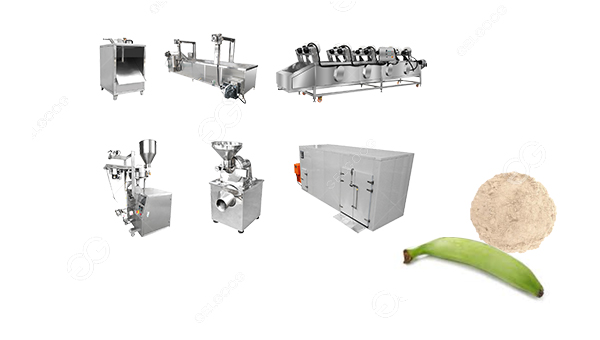Banana flour, a versatile and nutritious alternative to traditional wheat flour, has been gaining popularity in recent years due to its gluten-free properties and health benefits. But have you ever wondered what is the processing of banana flour? Join us on a journey through the processing of banana flour in the factory, from the green banana to the final packaged product.

1. Peeling:
It all starts with the bananas. Green bananas, often deemed unsuitable for sale in their fresh, find a new purpose in the production of banana flour. These bananas are carefully unloaded and sorted in the factory to ensure only the highest quality fruits are used. Then, they undergo the peeling process. Automated machinery efficiently removes the peels, leaving behind the creamy, yellow flesh ready for the next step.
2. Slicing:
Once peeled, the bananas are sliced into uniform slices. Consistency is key in the production of banana flour to ensure even drying and milling later in the process. Advanced slicing machines handle this task with precision, creating slices of the optimal thickness to facilitate efficient drying.
3. Drying:
The sliced bananas move on to the drying phase, where they undergo dehydration to remove the majority of their moisture content. This step is crucial for extending the shelf life of the bananas and preserving their nutritional value. Various drying methods may be employed, including air drying, drum drying, or freeze drying, depending on the manufacturer’s preferences and the desired characteristics of the final product. Throughout the drying process, temperature and humidity levels are closely monitored to achieve optimal results without compromising the bananas’ quality.
4. Grinding:
Once dried to the appropriate moisture content, the banana slices are ready for grinding. This is where the transformation into flour begins. The dried banana slices are fed into grinding machines equipped with sharp blades or burrs that pulverize them into fine particles. The grinding process may occur in multiple stages to achieve the desired fineness and texture of the flour. Some manufacturers may also opt to sieve the flour to remove any larger particles and ensure uniformity.
5. Packaging:
With the banana flour finely ground, it’s time for the final step: Packaging. The flour is carefully transferred into packaging machinery, where it is measured and sealed into bags or containers of various sizes. Packaging materials are chosen to protect the flour from moisture, light, and air, ensuring its freshness and quality are preserved until it reaches the consumer. Labels indicating nutritional information, usage instructions, and branding are affixed to the packaging, providing consumers with essential information about the product.
From green bananas to versatile flour, the processing of banana flour in the factory involves several precise steps that culminate in a high-quality product ready for consumption. Each stage, from peeling to packaging, is meticulously executed to ensure the final flour meets the standards of taste, texture, and nutritional value expected by consumers. If you have any ideas of banana flour production, contact us, we can provide you complete banana flour production line.